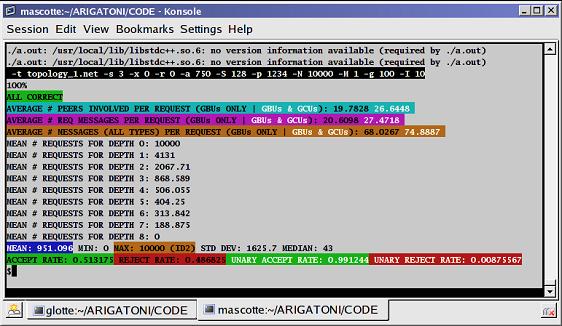ARIGATONI
Programmable
Overlay Network
for
Generic Resource Discovery
INRIA
Sophia Antipolis, LogNet Team

This page will collects some documents related with my new research
vein on Programmable Overlay Networks (Overlay Computers)
- AEOLUS -- FP6 ST FET Global Computing:
Algorithmic Principles for
Building
Efficient Overlay Computers (WIKI, CORDIS).
- The recent explosive growth of the Internet gives rise to the
possibility of a global computer of grand-scale consisting of
Internet-connected computing entities (possibly mobile, with varying
computational capabilities, connected among them with different
communication media), globally available and able to provide to its
users a rich menu of high-level integrated services that make use of
its aggregated computational power, storage space, and information
resources. Achieving this efficiently and transparently is a major
challenge that can be overcome by introducing an intermediate layer,
the overlay computer. The goal of this project is to investigate the
principles and
develop the algorithmic methods for building such an overlay computer
that enables this efficient and transparent access to the resources of
an Internet-based global computer.
- According to the AEOLUS Manifesto (GET-IT!),
Arigatoni fits into
- AEOLUS SP2: Resource Management - WP 2.1: Resource
Discovery GET-IT!
- AEOLUS SP3: Sharing Information and Computations - WP 3.4:
Workflow and Services
Arigatoni
- Capsule. The research program focus
on the study of foundations of programmable
overlay networks. Such overlays are built over a large number of
distributed computational individuals, virtually organized in colonies gouverned by a leader
(called broker),
democratically elected or imposed by system administrators (deux-ex-machina). Every
computational entities ask to the broker to log in the colony by
declaring their resources that the computee is ready to offer with
variable guarantee. Once logged, the individual can ask to the broker
for other resources. Colonies can recursively be considered as evolved individuals that can sign
in a outermost colony gouverned by another super-leader.
Communications and routing intra-colonies goes through a
broker-2-broker PKI-based negociation. Every broker route intra
and inter \emph{requests} by first filtering in its resource routing table and then
forwarding the request first inside its colony, and then forward the
request toward the proper super-leader (thus applying an endogenous-first-estrogen-last
strategy). Theoretically speacking, queries are formulŠ of first-order logics
equipped with a small imperative program used to orchestrate and synchronize atomic formulŠ.
When the client individual receive all (or part of) the requested
resources, then it is served directly by the others server(s)
individuals, without a further mediation of the leader, in a pure
peer-to-peer fashion. The proposed overlay promotes an
intermittent participation in the colony, since peers can appear,
disappear, and organize themselves dynamically. This implies that the
routing process may lead to failures, because some individuals have
logged out, or are temporarily unavailable, or they have been manu militari logged out by the
broker because of their poor performance or greediness.
- A two pages "resume" GET-IT!
- A general talk on Arigatoni and resource discovery protocol GET-IT!
- A specialized talk on the virtual intermittence protocol GET-IT!
Applications
- COLORS -- Action INRIA Sophia: Arigatoni on
Wheels (with Politecnico di Torino, ETH Zurich)
- The goal of the
project is the
definition of an info-mobility system
capable of proposing new development paradigms that focus on the
maximization
of communication efficiency and information exchange in Vehicle-to-Vehicle
(V2V) and Vehicle-to-Infrastructure
(V2I) communication. Such goals can be pursued without devising new
communication technologies, but, rather, by aiming at a drastic
technological
upgrading of existing infrastructures and at devising a lightweight
overlay
network called Arigatoni, designed at
INRIA Sophia Antipolis in Mascotte Project
Team and
mathematically investigated in Maestro Project Team. The
“Arigatoni-On-Wheels”
project will therefore specify and investigate models, algorithms and
protocols
that can promote an efficient interactivity among all the elements of
traffic
systems (vehicles, roadside infrastructures and service centres).
People
Past Members
Papers
- D. Borsetti, C. Casetti, C. F. Chiasserini and L. Liquori. Content Discovery in Heterogeneous Mobile Networks. In Heterogeneous Wireless Access Networks: Architectures and Protocols, Springer-Verlag, book chapter, invited, 2008. GET-IT!
- L. Liquori, D. Borsetti, C. Casetti, and C. F. Chiasserini.
An Overlay Architecture for Vehicular Networks. In Proc. of IFIP
Networking-08. International Conferences on Networking, Lecture Notes in Computer Science,
4982, pages 60--71, Springer-Verlag, 2008. GET-IT!
- L. Liquori, M. Cosnard. Logical Networks: Towards
Foundations of
Programmable Overlay Networks and Overlay Computing Systems:
In Proc.
of TGC-07. International Symposium on Trustworthy Global Computing, Lecture
Notes in Computer Science, 4912, Springer-Verlag,
2008. GET-IT!
- This paper is our
manifesto! Probably it is one
of the first you may have a look.
- R. Chand, M. Cosnard,
L. Liquori. The Arigatoni
Overlay Network: An Improved Resource Discovery Protocol. Future
Generation Computer Systems, 24(1), pp 31--38,
Elsevier, 2008. GET-IT!
- M. Cosnard, L. Liquori. Weaving Arigatoni with a graph
topology: In Prof. of ADVCOMP-07. International Conference on Advanced
Engineering Computing and Applications in Sciences, IEEE
Computer Society, to
appear, 2007. GET-IT!
- This paper presents the
first paper using a graph topology.
- R. Chand, M. Cosnard, L. Liquori.
Improving Resource Discovery in the Arigatoni Overlay Network. In Proc.
of ARCS'07: 20th International Conference on Architecture of
Computing Systems System Aspects in Pervasive and Organic Computing,
Lecture Notes in Computer Science, 14 pages, to appear,
Springer-Verlag, 2007. GET-IT!
- This paper presents the
resource discovery protocol RDP V2.
- R. Chand, M. Cosnard, L. Liquori.
Resource Discovery in the Arigatoni Overlay Network. In Proc. of I2CS'06,
International Workshop on Innovative Internet Community Systems,
Neuchatel, Switzerland. Lecture Notes in Computer Science, 13
pages, to appear, Springer Verlag, 2007. GET-IT!
- This paper presents the
resource discovery protocol V1.
- M. Cosnard, L. Liquori, R. Chand.
Virtual Organizations in Arigatoni. In Proc. of DCM'06, 3rd
International Workshop on Developments in Computational Models,
Venice, Italy. Electronic Notes in Theoretical Computer Science,
22 pages, to appear, Elsevier, 2007. 22 pages = journal version. GET-IT!
- This paper present the
virtual intermittent protocol VIP V1.
- D. Benza, M. Cosnard, L. Liquori, M. Vesin.
Arigatoni: A Simple Programmable Overlay Network. In Proc. of JVA'06,
John Vincent Atanasoff International Symposium on Modern Computing,
Sofia, Bulgaria, pages 82--91, IEEE Computer Society, 2006. GET-IT!
- This paper is the "father" of
all the above.
Software (simulator of papers 1,2)
- GET-IT-LINUX! or GET-IT-OSX!
- Capsule. The resource discovery algorithm was
implemented in C++ and compiled using GNU C++ version 2.95.3.
Experiments were conducted on a 3.0 Ghz Intel Pentium machine with 2GB
of main memory running Linux 2.4.28.
- Screenshot
- For a randomly generated topology GET-IT! we had
some simulations experiments C1 C2 C3 C4 C5
Case Study: Overlay for GRID Computing
(see the JVA paper for a complete example setup)
Once all resources are discovered in the Arigatoni Overlay, the
"resource orchestration" can take place, outside of the Arigatoni
Overlay and thanks to workflow-like languages. The most promising
language is JOpera.
Thanks to Cesare
Pautasso (ETH Zurich)
we programmed the
skeleton of the orchestration of this example in JOpera.
Stages/Internship/Post doc (drop a
mail to Luigi.Liquori-AT-sophia.inria.fr)
- GET-IT!
- Abstract.
Arigatoni is a structured multi-layer overlay computer providing
various services with variable guarantees, and promoting an
intermittent participation to the virtual organization where peers can
appear, disappear and organize themselves dynamically. Arigatoni mainly
concerns itself with how resources are declared and discovered in the
overlay, allowing global computers to make a secure (using standard PKI
mechanisms) use of global aggregated computational power, storage,
information resources, etc. Arigatoni provides fully decentralized,
asynchronous and scalable resource discovery, and provides mechanisms
for dealing with dynamic virtual organizations. Simulations show that
resource discovery in Arigatoni is efficient and scalable.
The explosive growth of the Internet gives rise to the possibility of
designing large overlay networks (a.k.a. virtual organizations)
consisting of Internet connected global computers (GC), able to provide
a rich functionality of services that makes use of its aggregated
computational power, storage, information resources, etc. The virtual
organization is hierarchically structured in colonies, governed by
global brokers (GB). A GB (un)registers GCs, receives service queries
from clients GCs, contacts potential servants GCs, trusts clients and
servers and allows the clients GC and the servants GCs to communicate.
Registrations and requests are performed via a simple query language
Ó
la SQL and a simple orchestration language Ó la JOPERA.
Communication
intra-colony is initiated via only one GB, while communication
inter-colony is initiated through a chain of GB-2-GB message exchanges.
Once the resource offered by a global computer has been found in the
overlay network, the real resource exchange is performed out of the
overlay itself, in a peer-to-peer fashion. The main challenges in
Arigatoni lie in the management of an overlay network with a dynamic
topology, the routing of queries and the discovery of resources in the
overlay. In particular, resource discovery is a non trivial problem for
large distributed systems featuring a discontinuous amount of mobile
resources offered by global computers and an intermittent participation
in the overlay. Thus, Arigatoni features two protocols: the virtual
intermittence protocols, VIP, and the resource discovery protocol RDP.
The VIP protocol deals with the dynamic topology of the overlay, by
allowing individuals to login/logout to/from a colony. This implies
that the process of routing may lead to some failures, because some
individuals have logged out, or are temporarily unavailable, or because
they have been "manu military" logged out by the broker because of
their poor performance or avidity.




